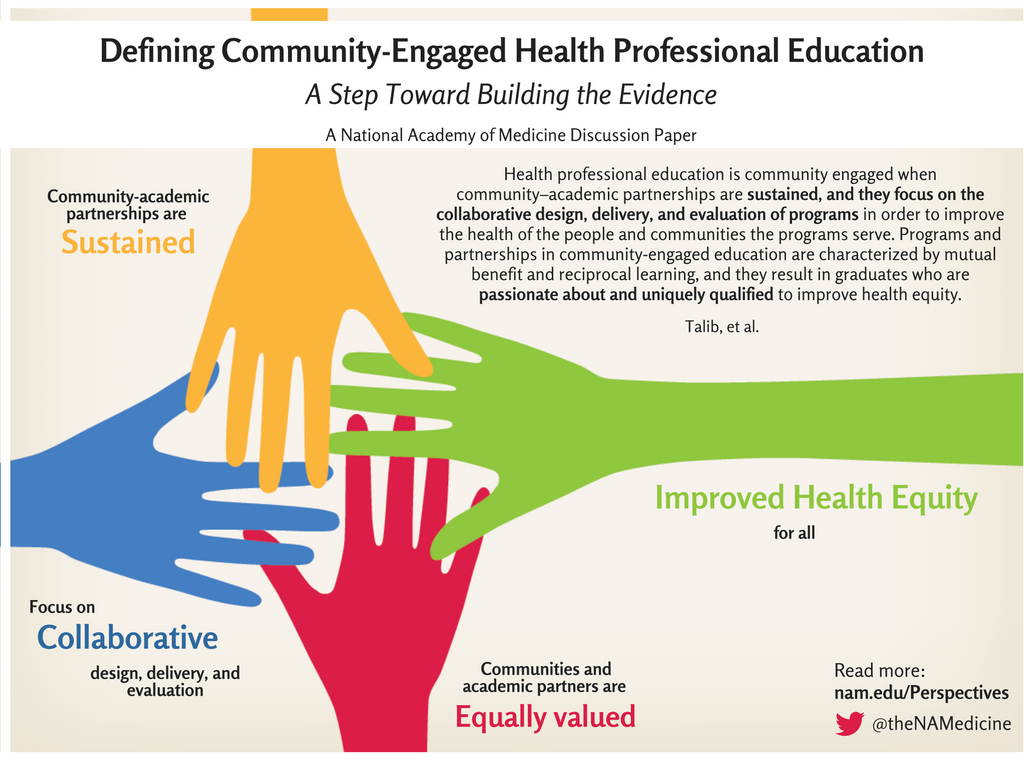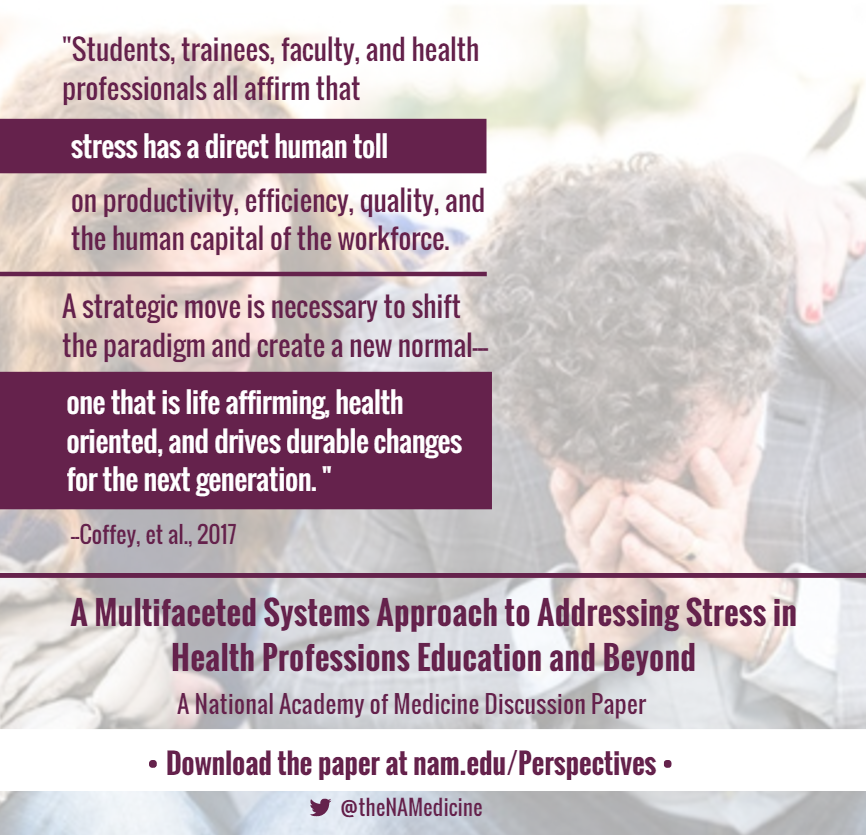Browse all publications released in January 2017 below. To receive updates from the NAM, please subscribe to our mailing list.
Reports document the evidence-based consensus of an authoring committee of experts. Proceedings chronicle the presentations and discussions at a workshop, symposium, or other convening event. Perspectives are individually-authored expert commentaries and discussion papers from leading voices in health and health care.
January 4, 2017 | NAM Perspective [space height=”HEIGHT”]Community-engaged health professional education is a mechanism for learning how to work in and with communities while obtaining the attributes just listed. Developing socially accountable individuals and institutions within a health system is key to improving the health and well-being of present and future societies.Health professional schools with a commitment to social accountability are distinguished by their “obligation to direct their education, research, and service activities toward addressing the priority health concerns of communities, region, and /or nation they have a mandate to serve.” What has become evident is the lack of published literature analyzing learning taking place in and with communities that has a demonstrated value to that community. [space height=”HEIGHT”]Download the paper >>

Driving Action and Progress on Obesity Prevention and Treatment
January 4, 2017 | NASEM Proceedings of a Workshop-in Brief
Have we begun to tip the scales towards achieving a healthy weight for all Americans? What are the best bets and most promising opportunities that will drive future progress and action in obesity prevention and treatment, and what obstacles need to be overcome? The Roundtable on Obesity Solutions of the Health and Medicine Division of the National Academies of Sciences, Engineering, and Medicine held a workshop titled, “Driving Action and Progress on Obesity Prevention and Treatment” to address these questions.
Using 21st Century Science to Improve Risk-Related Evaluations
January 5, 2017 | NASEM Report
Over the last decade, several large-scale United States and international programs have been initiated to incorporate advances in molecular and cellular biology, -omics technologies, analytical methods, bioinformatics, and computational tools and methods into the field of toxicology. Similar efforts are being pursued in the field of exposure science with the goals of obtaining more accurate and complete exposure data on individuals and populations for thousands of chemicals over the lifespan; predicting exposures from use data and chemical-property information; and translating exposures between test systems and humans.
Review of WIC Food Packages: Improving Balance and Choice
January 5, 2017 | NASEM Report
To assure the continued success of the WIC, Congress mandated that the Food and Nutrition Service of the U.S. Department of Agriculture (USDA) reevaluate the program’s food packages every 10 years. In 2014, the USDA asked the Institute of Medicine to undertake this reevaluation to ensure continued alignment with the goals of the Dietary Guidelines for Americans. In this third report, the committee provides its final analyses, recommendations, and the supporting rationale.

Review of NASA’s Evidence Reports on Human Health Risks
January 6, 2017 | NASEM Report
The National Academies of Science, Engineering and Medicine at the request of the National Aeronautics & Space Administration (NASA) and with guidance from the National Academies’ Standing Committee on Aerospace Medicine and the Medicine of Extreme Environments, has established a committee to review NASA’s Evidence Reports on Human Health Risks. These evidence reports focus on human health risks for long-duration and exploration spaceflights. To review the eight NASA evidence reports that were examined in 2016, the National Academies assembled a 13-member committee with multidisciplinary expertise.
International Perspectives on Integrating Ethical, Legal, and Social Considerations into the Development of Non-Invasive Neuromodulation Devices
January 9, 2017 | NASEM Proceedings of Workshop-in Brief
Emerging neurotechnologies—devices and techniques designed to collect information about the brain or affect its function—are becoming increasingly important due to scientific and technological advances and a persistent need to develop effective therapies to address the large global burden of neurological and psychiatric disease. The Organisation for Economic Co-operation and Development (OECD)—in collaboration with Arizona State University and the National Academies of Sciences, Engineering, and Medicine—held a workshop in Washington, DC, on Neurotechnology and Society: Strengthening Responsible Innovation in Brain Science. As part of this overall workshop, the Forum on Neuroscience and Nervous System Disorders of the National Academies organized a session that used non-invasive neuromodulation as a case study to prompt further, concrete discussion about concerns and opportunities related to better integration of societal values, scientific advancement, and economic considerations during the development and use of novel neurotechnologies. The workshop rapporteurs have prepared this proceedings as a factual summation of the session discussions.
Accounting for Social Risk Factors in Medicare Payment
January 10, 2017 | NASEM Report
The Department of Health and Human Services, acting through the Office of the Assistant Secretary for Planning and Evaluation, asked the National Academies of Sciences, Engineering, and Medicine to convene an ad hoc committee to identify social risk factors that affect the health outcomes of Medicare beneficiaries and methods to account for these factors in Medicare payment programs. In this fifth and final report, the committee puts the entire series in context and offers additional thoughts about how to best consider the various methods for accounting for social risk factors, as well as next steps.
Communities in Action: Pathways to Health Equity
January 11, 2017 | NASEM Report
Health equity is the state in which everyone has the opportunity to attain full health potential and no one is disadvantaged from achieving this potential because of social position or any other socially defined circumstance. Currently in the United States, the burdens of disease and poor health and the benefits of well-being and good health are inequitably distributed with negative consequences for the nation’s wellbeing, prosperity, and economic competitiveness. Although some aspects of a person’s health status depend on individual behaviors and choice, health is also shaped by community-wide factors, and research shows that problems like poverty, unemployment, low educational attainment, inadequate housing, lack of public transportation, exposure to violence, and neighborhood deterioration (social or physical) shape health and contribute to health inequities.
This report is the first in a series of consensus reports to emerge from the National Academy of Medicine’s Culture of Health program.

The Health Effects of Cannabis and Cannabinoids: The Current State of Evidence and Recommendations for Research
January 12, 2017 | NASEM Report
In one of the most comprehensive studies of recent research on the health effects of recreational and therapeutic cannabis use, a new report from the National Academies of Sciences, Engineering, and Medicine offers a rigorous review of relevant scientific research published since 1999. This report summarizes the current state of evidence regarding what is known about the health impacts of cannabis and cannabis-derived products, including effects related to therapeutic uses of cannabis and potential health risks related to certain cancers, diseases, mental health disorders, and injuries. Areas in need of additional research and current barriers to conducting cannabis research are also covered in this comprehensive report.
A Model Framework that Integrates Community and Clinical Systems for the Prevention and Management of Obesity and Other Chronic Diseases
January 13, 2017 | NAM Perspective
Obesity now affects 35 percent of men, 40 percent of women, and 17 percent of 2- to 19-year-old children and adolescents in the United States. Neither clinical nor environmental changes alone are sufficient to address a problem of this magnitude.
In this perspective, the authors review many of the elements and challenges associated with the integration of clinical and community systems to prevent and manage obesity. Although the focus of this perspective is on obesity, our experience suggests that a model that integrates clinical and community services has much wider applicability to other chronic diseases, such as heart disease, asthma, adverse childhood experiences, and autism spectrum disorders.

Community Violence as a Population Health Issue
January 17, 2017 | NASEM Proceedings of a Workshop
On June 16, 2016, the Roundtable on Population Health Improvement held a workshop in Brooklyn, New York, to explore the influence of trauma and violence on communities. The workshop was designed to bring attention to the impact of racism and violence on communities; some social and physical interventions that can change landscapes of violence; some local strategies to build community resilience and safety; some lessons learned from select approaches and initiatives designed to reduce community violence, and public health-informed approaches to community policing and collaboration. This Proceedings of a Workshop synthesizes the presentations and discussions that occurred during the workshop, Community Violence as a Population Health Issue.
Getting to Equity in Obesity Prevention: A New Framework
January 18, 2017 | NAM Perspective
High obesity prevalence persists as a major issue for societies globally. Chronic overweight and obesity have high health, social, and economic costs, and the benefits of achieving and maintaining healthy weight for overall health and well-being are well established. Obesity in children and adolescents is of particular concern because it may compromise physical and psychosocial development and set the stage for early onset of adverse health effects that accumulate over a lifetime. Relevant to the topic of this discussion paper, obesity is also a health equity issue. Social disadvantage tends to intensify the exposure to obesity-promoting influences. The challenge of preventing and controlling obesity includes the need to assure that socially disadvantaged populations benefit from relevant public health interventions.
A Multifaceted Systems Approach to Addressing Stress Within Health Professions Education and Beyond
January 30, 2017 | NAM Perspective
There are unique stressors faced by health professionals that begin during the educational process and continue throughout training and into practice. While stress is expected owing to the intense nature of the work in health care, the systems in which faculty and health professionals work often intensifies this already stressful environment and can lead to negative mental and physical effects. Stress takes a major toll on individuals and has been reported to increase absenteeism, errors, burnout, and substance use, and it can even lead to individuals quitting the health professions altogether.

100 Days of Rain: A Reflection on the Limits of Physician Resilience
January 30, 2017 | NAM Perspective
By January 1999, it rained, they say, for over 100 days in a row; Seattle has a reputation for precipitation, which I have to believe could lead to higher rates of seasonal affective disorder and the need for strong coffee. It was during this month that I can say I may have reached my low point. I was a young, insecure, and nervous intern in the Harborview Medical Center intensive care unit that month—one in which our attending physician later admitted was the busiest of his long career. Myself and my senior resident, Phil, came to expect the admission of more than 10 critically ill patients every fourth night.
Harnessing Evidence and Experience to Change Culture: A Guiding Framework for Patient and Family Engaged Care
January 31, 2017 | NAM Perspective
Patient and family engaged care (PFEC) is care planned, delivered, managed, and continuously improved in active partnership with patients and their families (or care partners as defined by the patient) to ensure integration of their health and health care goals, preferences, and values. It includes explicit and partnered determination of goals and care options, and it requires ongoing assessment of the care match with patient goals.
A prevalent and persistent challenge to a system-wide transformation to PFEC is uncertainty about whether the resource investment required will lead to better results. There is also a lack of clarity about how, practically speaking, to make it happen.

